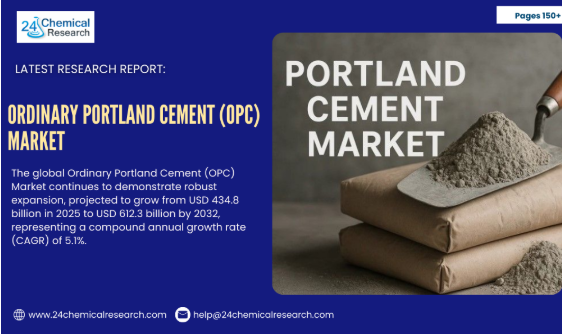The Future of the Ordinary Portland Cement Market: Opportunity, Risk, and Innovation
Executive Summary
The Ordinary Portland Cement (OPC) market stands at a pivotal juncture characterized by a convergence of robust growth drivers, evolving environmental regulations, and groundbreaking technological advancements. As we look towards 2032, the market is expected to chart a significant growth trajectory, from USD 434.8 billion in 2025 to USD 612.3 billion by 2032, equating to a compound annual growth rate (CAGR) of 5.1%. This growth is spurred by infrastructure development, urbanization, and an unprecedented push towards sustainability. However, along with these opportunities come various risks including supply chain disruptions, fluctuations in raw material costs, and the imperative for innovation in alternative materials.
This article presents an in-depth analysis of the ongoing trends, market drivers, and risks within the OPC landscape, elaborating on the interplay between opportunity and sustainability while providing actionable insights for investors and industry stakeholders.
Main Analysis
Current Market Dynamics and Growth Drivers
-
Infrastructure Spending and Urbanization: Governments, especially in emerging economies like China and India, are channeling significant investments into large-scale infrastructure projects. India’s National Infrastructure Pipeline and China’s Belt and Road Initiative are leading the charge. These programs are critical in not only stimulating demand for OPC but also enhancing the quality of infrastructure in regions that greatly need it.
-
Technological Advancements: The cement industry is undergoing a tech-driven transformation, aided by innovations such as high-efficiency grinding mills and the integration of alternative fuels. Automation and digitalization are becoming crucial components of the production process, enabling better efficiency and cost optimization. This transition signifies an industry response to both market demands and environmental imperatives.
-
Sustainability Imperative: As the world grapples with climate change, the demand for low-carbon and eco-friendly building materials is intensifying. Leading cement manufacturers are increasing investments in green technologies and carbon capture utilization (CCU) strategies. These efforts are vital not only for compliance with regulatory pressures but also for maintaining a competitive edge.
Emerging Opportunities
-
Carbon Management Innovations: The development of CCU technologies that convert industrial CO2 waste into usable byproducts represents a critical avenue for innovation. Companies that successfully implement CCU can position themselves as leaders in the push for sustainability while potentially discovering new revenue streams.
-
Smart Cement Applications: The advent of “smart cement”—or cement with embedded sensors for structural health monitoring—opens a new frontier in the industry. The integration of IoT with building materials is a burgeoning niche awaiting exploration and could greatly enhance safety and durability in construction.
-
Market Potential in Underrepresented Regions: The Middle East’s ambitious projects like NEOM underscore a growing market need, with minerals and resources in high demand. Similarly, Africa’s significant housing deficit presents an additional layer of opportunity, reflective of a continent’s rapid urbanization quest.
Risks Affecting the Market
-
Supply Chain Challenges: The lingering effects of the COVID-19 pandemic continue to shake global supply chains. Cement manufacturers face delays in raw material procurement and higher transportation costs, impacting production efficiency and market pricing.
-
Material Scarcity: The volatility in the availability of essential materials such as limestone and clay could undermine production capabilities. Cement firms need to strategize around resource procurement, potentially developing partnerships to stabilize supply chains.
-
Regulatory Compliance Costs: Increased regulatory scrutiny surrounding carbon emissions presents a dual-edged sword. While compliance is essential for sustainable operation, the financial burden of upgrading facilities to meet such standards could impact profitability, particularly for smaller players.
Future Trends to Monitor
-
Alternative Cement and Materials: The exploration of geopolymer cements and calcium sulfoaluminate (CSA) cements signifies a shift towards more sustainable building materials. These alternatives not only reduce emissions but offer unique mechanical properties attractive to a diverse range of applications.
-
Regional Market Variability: The Asia-Pacific region will continue to dominate the OPC market due to rapid urbanization and government initiatives. Conversely, North America and Europe are experiencing a growth rate less pronounced than in other regions, driven largely by sustainability trends rather than new infrastructure projects.
-
Digital Transformation: The ongoing shift toward automation and data analytics will imprint significant influences on production efficiency and strategic decision-making. Firms that proactively embrace digital tools will likely flourish as they efficiently manage resources and respond to market demands.
Conclusion
The OPC market is at a crucial point of evolution, straddling the line between opportunity and sustainability. As growth expands in dynamic regions like Asia and Africa, so too does the imperative for innovation in production methodologies and sustainability measures. For investors and builders, the opportunities within the OPC landscape are abundant; however, they are accompanied by notable risks that require astute management and forward-thinking strategies.
Call to Action
To capitalize on the emerging trends and mitigate risks, stakeholders in the industry should prioritize investments in R&D focused on sustainable practices, explore new market opportunities in underrepresented demographics, and adopt technological innovations aimed at operational efficiency. As the future of the OPC market unfolds, it is crucial for industry players to remain agile, adaptive, and forward-thinking to navigate the complexities and embrace the innovations that will shape the construction landscape of tomorrow.
Disclaimer for Uncirculars, with a Touch of Personality:
While we love diving into the exciting world of crypto here at Uncirculars, remember that this post, and all our content, is purely for your information and exploration. Think of it as your crypto compass, pointing you in the right direction to do your own research and make informed decisions.
No legal, tax, investment, or financial advice should be inferred from these pixels. We’re not fortune tellers or stockbrokers, just passionate crypto enthusiasts sharing our knowledge.
And just like that rollercoaster ride in your favorite DeFi protocol, past performance isn’t a guarantee of future thrills. The value of crypto assets can be as unpredictable as a moon landing, so buckle up and do your due diligence before taking the plunge.
Ultimately, any crypto adventure you embark on is yours alone. We’re just happy to be your crypto companion, cheering you on from the sidelines (and maybe sharing some snacks along the way). So research, explore, and remember, with a little knowledge and a lot of curiosity, you can navigate the crypto cosmos like a pro!
UnCirculars – Cutting through the noise, delivering unbiased crypto news







